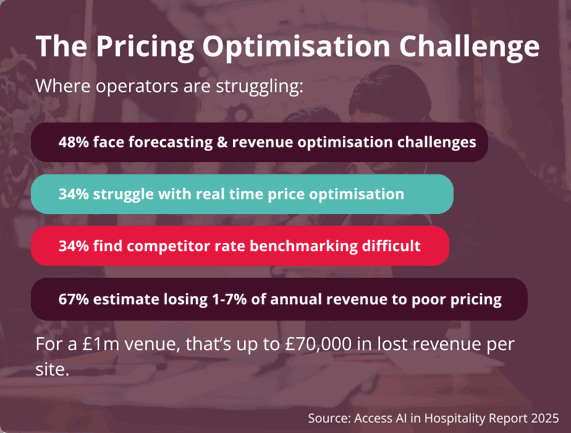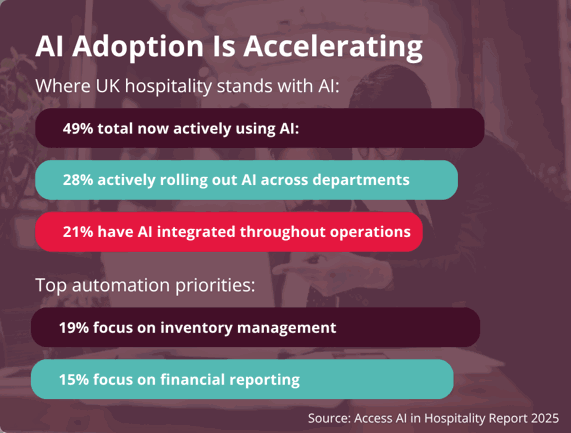
Why does dynamic pricing matter for hospitality operators?
The scale of the pricing problem facing UK hospitality is staggering. In our survey, 48% of operators reported that forecasting and revenue optimisation is a moderate to significant operation challenge, while 34% struggle to get real-time price optimisation right. The result? Pricing decisions based on data operators don’t trust, made in spreadsheets that can’t respond to real time demand. For a 50-room hotel, these delays cost up to £20,000 per month in missed revenue.
The impact on hospitality business revenue is substantial, 67% of operators estimate that poor real time price optimisation costs them between 1-7% of annual revenue per site, with some reporting losses exceeding 15%.
And for consumers, the time is now. 57% say technology has significantly improved their hospitality experience – they’re ready for smarter, more responsive pricing.
What do guests expect from pricing today?
Pricing is an integral part of the guest experience. And today’s guests are doing their homework. According to ResDiary data, 49% of UK diners book dinner reservations a week or more in advance, and almost half research venues by looking at menus online before booking. This means pricing needs to be visible, consistent and reflective of the experience on offer.
But here’s what matters most, while 53% of guests cite value for money as a key factor in return visits, value extends beyond price. According to our own Loyalty Report, 71% of over-55s prioritise food quality, while younger guests are more likely to seek experiences they can’t replicate at home. Guests aren’t just looking for the cheapest option, they’re looking for quality and clarity. And while 21% of consumers in our report say they’d be willing to pay extra for AI-enhanced services that significantly improve their experience, that figure jumps to 57% among frequent visitors (those who visit hospitality venues multiple times a week). This tells us that your most valuable guests, your regulars, are ready to pay premium prices for technology-driven experiences that deliver genuine value.
The picture is becoming clear, when it comes to dynamic pricing it isn’t about charging more – it’s about charging right, at the right time, for the right guests.
What guests expect from pricing
-
Fair pricing that reflects quality and availability
-
Clear menu visibility before booking
-
Value for money, not just low prices
-
Technology-enhanced experiences worth paying for
What the data tells us
-
49% book a week or more in advance
-
53% say value for money drives repeat visits
-
71% of over-55s prioritise food quality
-
21% of all consumers willing to pay extra for AI-enhanced services
-
57% of frequent visitors willing to pay extra for enhanced experiences
How dynamic pricing helps meet expectations
-
Adjusts pricing based on real-time demand and availability
-
Supports upselling and bundling of premium experiences
-
Enables technology-driven services that frequent guests value
-
Helps operators maintain margins while offering perceived value
-
Builds trust through transparent, responsive pricing
How AI pricing tools work in hospitality
AI adoption in hospitality is accelerating, with nearly half of operators (49%) now actively using AI. As automation priorities shift, 19% of businesses are focusing on inventory management and ordering, while 15% prioritise financial reporting and data consolidation, both critical foundations for effective dynamic pricing.
How can AI help you make smarter pricing decisions?
AI analyses historical and real-time data
-
AI pricing engines use booking history, seasonal trends and live demand signals
-
This helps forecast occupancy, identify peak trading windows and spot pricing gaps
-
Operators can plan ahead with confidence and avoid under-pricing or over-discounting
Rate changes are automated across channels
-
AI tools automatically adjust pricing across OTAs, direct booking platforms and POS systems
-
This ensures consistency and avoids manual errors or delays
-
Operators save time and reduce the risk of missed revenue opportunities
Upsell opportunities are identified in real time
-
AI tracks guest behaviour and booking patterns to suggest upsells
-
For example, premium room upgrades during local events or bundled dining packages
-
This helps increase average spend without relying on blanket discounts
What are predictive analytics for pricing strategies?
Predictive analytics helps operators move from reactive pricing to proactive planning. By analysing historical booking data, seasonal trends and real time demand signals, AI tools can forecast future performance and recommend optimal rates.
Predictive analytics enable operators to:
-
Forecast demand with greater accuracy across locations and time periods
-
Avoid underpricing during high-demand periods or overpricing at quieter times
-
Support long term planning for seasonal events, promotions and staffing
How hotels and restaurants use dynamic pricing
Dynamic pricing is not one-size-fits all. Hotels and restaurants use it in different ways to reflect demand, availability and guest expectations. AI tools help tailor pricing strategies to each outlet’s needs.
Pricing strategies for hotels using AI tools
-
Adjust room rates based on demand, local events and booking patterns
-
Bundle experiences like spa treatments, dining or late checkout to increase value
-
Use CRM data to personalise offers for loyalty members or repeat guests
Hotels can optimise RevPAR and upsell opportunities while maintaining rate integrity across OTA channels.
Pricing strategies for restaurants using AI tools
-
Optimise menu pricing based on ingredient costs, demand and time of day
-
Adjust pricing for peak times, seasonal menus or special events
-
Upsell premium experiences like tasting menus, wine pairings or priority seating
Restaurants can balance profitability with perceived value, especially when guests are comparison-shopping online.
What dynamic pricing means for your team
AI-powered pricing tools don’t just improve revenue. They support smarter decision-making across commercial, marketing and finance teams.
See how each role benefits from better data, faster responsiveness and clearer performance insights:
|
Commercial Managers |
Digital Marketing Managers |
Finance Directors |
|
Manage rates across OTA channels, seasons and locations |
Communicate value through personalised pricing and offers |
Gain real time visibility into pricing performance and demand trends |
|
Use AI to recommend upsells and bundled packages |
Use AI to A/B test strategies and track conversions |
Align pricing strategies with financial goals and margin targets |
|
Monitor performance across outlets and adjust strategies in real time |
Target loyalty members with exclusive early-access rates or bundles |
Monitor RevPAR, upsell conversion and profitability across venues |
How Access Evo supports smarter pricing decisions
Here's the thing: when 48% of operators struggle with forecasting and your team wastes 56 working days switching between systems, you don't need another tool - you need your existing tools to actually talk to each other.
That's what Access Evo does. It connects your EPoS, bookings, inventory and guest data in one place, so you can finally see the complete picture when making pricing decisions.
What changes for your team
-
Ask "What's our RevPAR trend?" and get instant visual answers (not hours of report-hunting)
-
Spot pricing opportunities as they happen, not after they've passed
-
Save those 56 wasted days and redirect that time toward strategy, not admin
Real results
Hotels using Access Evo's booking engine see conversion rates of 2.5-7%. Operators across venues, single sites to multi-location groups, benefit from having pricing data that's actually connected to what's happening in their business.
Making every decision a smarter decision.
What if pricing didn’t feel like guesswork?
It’s clear from our research that forecasting is a continuous challenge for operators and pricing optimisation happens too slowly, if it happens at all. And revenue is being lost due to lack of data visibility and disconnected systems.
In this article we’ve looked at the challenges hospitality operators are facing when it comes to more dynamic pricing strategies and the tools that help you make faster and smarter decisions.
Now the question isn’t whether smarter pricing is possible, it’s whether you’re ready to make it happen.
What’s next?

 AU & NZ
AU & NZ
 SG
SG
 MY
MY
 US
US
 IE
IE


